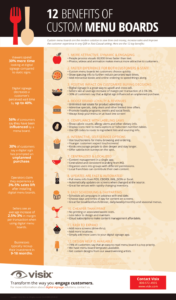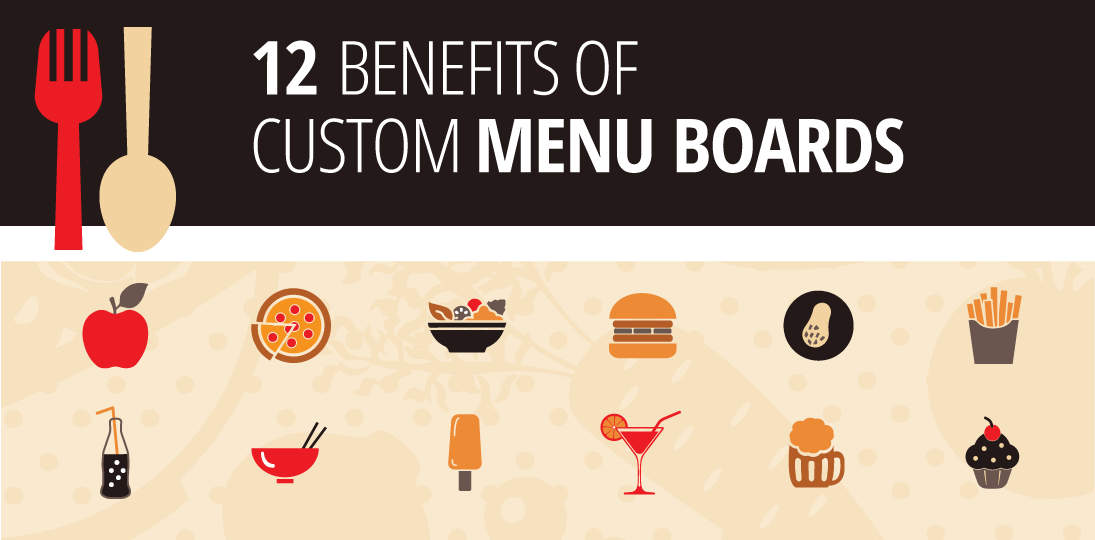Custom menu boards are the modern solution to save time and money, increase sales and improve the customer experience in any QSR or fast-casual setting. Let’s start with some impressive stats:
- 56% of consumers say they have been influenced by a menu board.
- 30% of customers said that a digital sign motivated them to make an unplanned purchase.
- Operators claim they experienced a 3%-5% sales lift after installing digital menu boards.
- Sellers also saw an average increase of margin per transaction of 2.5%-3%.
- Businesses typically recoup their investment in 9-18 months.
- Digital signage decreases a customer’s perceived wait time by up to 40%.
- Viewers spend 30% more time looking at digital signage compared to static signs.
- 74% of customers say that an easy-to-read menu board is a top priority.
Now let’s explore some of the top benefits of custom menu boards:
1. More attractive, dynamic and engaging
Using high-resolution photos, videos and animation on custom menu boards makes them more attractive to customers than printed lists or posters. People process images 60,000 times faster than text, so by engaging your patrons visually, you can greatly increase customer satisfaction, retention, and repeat business – all while improving the customer experience.
And, by putting dynamic menu designs and promos on bright displays, you’ll grab and hold customers’ attention longer, giving you more opportunity to increase their purchases and bond with your brand.
2. Faster experience for both customers and staff
Because digital menu boards provide a bright, attractive list of options that’s easy to read, customers can make their selection more quickly. This helps lines to move faster, and if there is a queue, having dynamic visuals on screens reduces perceived wait times for your patrons.
If you add interactive kiosks for ordering, you can speed up the process even more. And combining an online order system with in-store queuing info shown on digital signs makes that process fast and easy for everyone.
3. Positive impact on customers’ buying decisions
Digital signage is a great way to upsell and cross-sell. Use custom menu boards to advertise specials, daily deals and other limited time offers. If you have stock that isn’t moving, you can highlight it on screens to move that product. Because screens can change quickly, you can experiment with new offers and track sales during those campaigns to adjust your strategy.
4. Boost brand loyalty and revenues
Because screens give you virtually unlimited real estate, you can use them to advertise your products, brand, special offers, loyalty programs, events and even basic info like opening and closing hours.
You can also use your screens to build your brand community with social media feeds, online contests, recipes – anything that engages and bonds your customers. Of course, you’ll want to always have at least one screen showing your custom menu board, so you don’t distract from your primary business.
5. Compliance with labeling laws
Regulations that require operators to display nutritional information are easy to meet and maintain with digital menus. Custom menu boards can show calorie counts, allergy alerts and other dietary information with quick icons next to menu options or full tables that replace printed posters.
You can also include QR codes to let patrons access extensive information like ingredient lists and sourcing on your website.
6. Interactive, self-service options
If you make your custom menu boards interactive, your customers can navigate through your menu, specials and other messaging on their own. Using touchscreens especially appeals to younger customers, and it frees up your staff by accelerating purchases and pickups.
This is also a great way to offer surveys, loyalty program sign-ups and other programs that can marry your online and in-store experiences.
7. Centralized and localized
A single digital signage software platform can give central control of your menu boards to HQ, while still allowing local franchise owners to contribute content. That way, branding and mainstay menu items can be maintained by corporate, and they can roll out any national promotions from a single app. Branch locations can then add in their own regional ads and promos using the same system.
A good content management system will let you add users in different groups with different permissions, so you can organize content mangers using the same hierarchy as your business. And by using a centralized platform, all basic design and brand standards can be consistent.
8. Updates are fast and automated
Most content management systems let you tie into your POS, or pull in menu data from other sources like CBOARD, XML, JSON or even Microsoft Excel. This makes it very easy to update your custom menu boards, because they’ll automatically update when items are changed in the source application.
This is very handy if you have a rapidly-changing inventory, or you run out of stock on something.
9. Easy Scheduling and dayparting
Menu changes, new screen designs and promotions can be scheduled in advance and drop off of screens when you tell them to. This is much more convenient than having to place and retrieve promotional posters on walls or popups on tables.
Dayparting lets you schedule different content on different days and times of day, so your screens will automatically switch to show breakfast/lunch/dinner menus, daily/weekly/monthly menus and seasonal specials. Again, this is a huge advantage compared to handling these changes manually.
10. Cheaper than print
Although you’ll have to initially invest in the hardware (displays, networking, etc.), design services and some training, most software vendors offer cloud-based digital signage software subscriptions, so you can pay a simple monthly fee once you’re up and running.
Over time, updating custom menu boards on screens is much more economical than reprinting menus – not to mention the real and environmental costs of all that printing waste. It also gives you the opportunity to change your menu more often, which can open up new revenue streams.
11. Easy to expand
If you want to add more screens (like a drive-thru) or new locations, it’s just a matter of installing the displays and adding users to the content management system. More than likely, the main branding and menus will be the same, so it’s as easy as publishing from the central system out to the new endpoints.
12. Design help is available
At Visix, your custom menu board can start from a basic template, then morph into your own design. Our Menu Board Kit lets you customize your logo, background imagery and colors, fonts and text styles, and your external data source.
Of course, if you want a fully customized menu board, whether static or interactive, our award-winning creative team can design whatever you need.
Interested in custom menu boards for your establishment? Contact us to get started.

Other references:
- https://www.visix.com/infographics/15-real-world-stats-that-prove-digital-signage-works/
- https://www.intouchinsight.com/resources/studies/menuboard-study-2019/
- https://www.dseg.org/digital-menu-boards-best-practices-from-an-expert/
- https://www.digitalsignagetoday.com/blogs/a-confluence-of-factors-pushing-digital-signage-into-the-mainstream/
- https://www.eclipsedigitalmedia.co.uk/top-benefits-and-roi-of-digital-menu-boards-2014/
